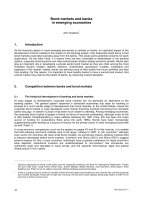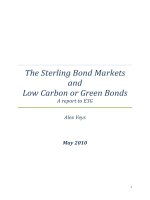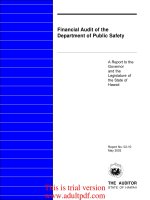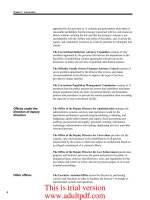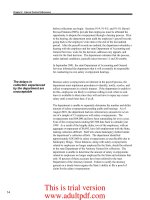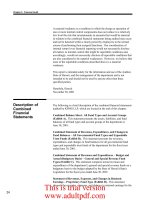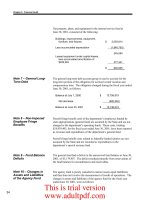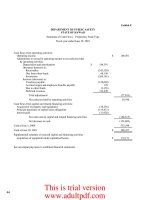The Sterling Bond Markets and Low Carbon or Green Bonds - A report to E3G ppt
Bạn đang xem bản rút gọn của tài liệu. Xem và tải ngay bản đầy đủ của tài liệu tại đây (511.48 KB, 38 trang )
TheSterlingBondMarkets
and
LowCarbonorGreenBonds
AreporttoE3G
AlexVeys
May2010
1
Abouttheauthor
Alexhasover20yearsexperienceinthebondmarkets,workingforbrokers,asaquantitativeanalyst
for10years,andforFidelityInvestmentsasaportfoliomanagerwherehemanagedalltypesof
bondfund.HealsochairedtheiBoxxoversitecommitteeforseveralyears.Hehasadeepknowledge
ofbonds,derivatives,investorsandbor
rowers.AlexleftFidelityin2007tocompleteaMastersin
SustainableEnergyatImperialCollege,London.Afteradvisingandworkingwithseveralcompanies
in2009,hehastakenuptheroleofChiefInvestmentOfficeratPartnershipAssurance.
2
1. ExecutiveSummary
1.1. TheUKBondmarketissmallcomparedtoglobalbondmarketsandbiasedtolongerdated,
andthereforeriskier,bonds.
1.2. TheUKBondmarketisvaluedatabout£1.2trillionwith£700billionofthismadeupofUK
governmentgilts.
1.3. Theinsuranceandpensionindustriesholdacom
binedvalueof£850billionofbondassets
(notallintheSterlingbondmarkets)andareclearlydominantbuyers.
1.4. AbouthalfthenumberofbondsintheSterlingmarketareissuedbyUKorganizations,
makingupabout75%ofitsmarketvalue.
1.5. Twoofthebiggestobstructionstopen
sionfundsinvestinginclimaterelatedinvestments
aretheirdeficitsandobscurecaselawdatingfroma1970smineworkersdispute.
1.6. Thereisonlyashorthistoryofgreenorclimaterelatedbonds.Thesewereinitiallyfocused
oncomplexproducts,scandinavianclientsortax‐driveninstruments.
1.7. Tremendousstructuraleff
ortsareneededtoincentivizepensionfundsandinsurance
companiestopurchaseclimaterelatedbonds.
1.8. IncentivessuchasguaranteesorinsurancefromtheUKgovernmentoranewGreen
InvestmentBankarelikelytoefficientlyleveragepublicmoney.
1.9. Taxincentives,likethoseofferedintheUSMunicipalbondmarket(10%ofthetot
alUSbond
market)couldbesuccessful.Thiswillleadretailinvestorsintothemarket,thoughthiswill
notraisethevolumesofcapitalneededwhichwillcomefromtheinstitutionalmarket
1.10. Greenorclimatebondswillneedtoreflectcurrentbondstructurestoaddressexisting
demand
.Newstructureswithoutfundamentaldemandfrommajorinvestorswillfail.
1.11. Thereisanurgentneedforaclimatebond“ratingagency”to“police” bon ds toensurethat
fundsareusedforgreeninvestmentsandthatinsuranceandguaranteescanthereforebe
reliablyoffered.
1.12. Welldesignedgreengilts,andaGreenIn
vestmentBank,willshowthattheGovernmentis
seriousandcommittedtotacklingclimatechangeaswellashelpingfinancelargeclimate
relatedprojects,leveragingpublicmoneyandleadingworldanddomesticmarkets.
3
Contents
Abouttheauthor 2
1. ExecutiveSummary 3
2. IntroductiontoBonds 6
2.1. History 6
2.2. RiskFeatures 6
2.3. LegalStatusandGrowthParticipation 7
2.4. CreditRatings 8
2.5. PrimaryandSecondaryMarkets 9
3. SterlingBondMarkets 11
3.1. GlobalContext 11
3.2. SterlingBonds 12
3.3. MarketSectors 12
3.3.1. DomesticBondsandBulldogs 12
3.3.2. EuroSterlingBonds 13
3.3.3. Glo
balBonds 13
3.4. TypesofBonds 13
3.4.1. ConventionalBonds 13
3.4.2. IndexedBonds 13
3.4.3. AssetBackedandSecuritizedBonds 14
3.5. IssuersaretheSupply 14
3.5.1. Country,IndustryandRatingsBreakdown 14
3.5.2. Gilts 17
3.5.3. OtherKeyIssuers 17
3.5.4. BondIssuerSize 17
3.5.5. USMunicipalBonds 17
3.6. BrokersaretheGlue 18
3.7. EndInvestorsaretheDe
mand 20
3.7.1. AssetsandLiabilities 21
3.7.2. PensionFundDeficits 22
3.7.3. ClimatechangeandPensionDecisions 22
4. GreenorLowCarbonBonds 24
4.1. History 24
4.1.1. WorldBankBonds 24
4
4.1.2. EIBBonds
25
4.1.3. USBonds 25
4.1.4. BreezeBonds 25
4.1.5. Overview 26
4.2. SourceofFunding 26
4.3. CharacteristicsandStructureofaGreenBondMarket 27
4.3.1. CarbonRatings 28
4.3.2. Incentives 28
4.3.3. GovernmentBonds 29
4.3.4. OtherAAARatedBonds 30
4.3.5. InvestmentGradeBonds 30
4.3.6. HighYieldBonds 31
4.3.7. WhatWillNotWork 31
4.4. Benefits
31
4.6 Movingforward 32
Appendix 33
A.1Glossary 33
A.2GiltEdgedMarketMakers(GEMMs) 34
A.3BondCalculations 35
A.3.1RunningorCurrentYield 35
A.3.2SimpleYield 35
A.3.3YieldtoMaturity 35
A.3.4OtherYieldCalculationMethods 36
A.3.5Duration 36
A.4TheYieldCurveanditsTheories 36
A.4.1Expectations 37
A.4.2Liquidityorriskaver
sion 37
A.4.3Segmentation 37
5
2. IntroductiontoBonds
BondscanvariouslybedescribedasIOUs,loansordebts.Theyaresimilartobankloans,
butgenerallylastlonger(from1yeartoover30years).Wheninstitutions,companies,govern ments
andotherentitieswanttoraiselongtermfinancebutdonotwanttodilutetheirshareholdings(or,
indeed,c
annotissuesharecapital─liketheUKGovernment),theyturntothebondmarkets.Here
theycanraisemoneywithouthavingtopayitbackforpossiblydecades.Ontheothersideofthe
dealaretheinvestors.ThebiggestinvestorsintheUKaretheinsurancecompaniesandpensi
on
funds.Theybuybondstogeneratereturn,offsettheirliabilities,generateincomeordiversifytheir
portfolios.
2.1. History
Beforeelectronicownershipofbondsbecamecommoninthelatterpartofthetwentieth
century,whenaninstitutionissuedbonds,thelenderreceivedacertificate.Thiswasoftenavery
elaborateandlargedocumentwithpicturesofwhateverthebondwasfinancing(trains,factories,
airplanesetc).Amongstotherinformationitalsosho
wedhowmuchthecertificatewasworth(i.e.
howmuchhadbe enborrowed),therateofinterest,thecurrencyandtheborrower.
Atthebottomofthecertificatewereanumberof“coupons”attachedtothemainbodyby
perforations(likestamps).Periodically,thelenderwouldgotothepayingagent
1
withthe
certificate;thepayingagentwouldtearofftherelevantcouponandhandovertheinterestpayment.
Atmaturity,thewholecertificatewouldbepresented,the“principal”(ornominalamount)ofthe
loanandfinalcouponpaidandthecertificatecancelled.Westillusethisslightlyarchaic
terminology
2
today,referringto“coupons”and“principal”eventhoughvirtuallyallbondsarenow
heldelectronically.
2.2. RiskFeatures
Whenaninvestorthinksaboutpurchasingabond,therearefourkeyriskattributesthatthey
willassesstodeterminewhetherthebondisagoodfitwiththeirportfolio,howlikelyitisthatthe
expectedreturnswillbeachieved andwhetherthepriceisfair.Theseattributesare:
itsissuer
itscurr
ency
itscoupon
itsmaturity
Issuer−Theissuerofthebond(i.e.borrowerofthemoney)definesthecreditriskofthebond.
Thatis,thelikelihoodthattheinvestorwillberepaidtheirinitialloan.Forexample,governmentsare
generallyconsideredtohavealowcr
editrisk(seesection2.4).
Currency−Akeydifferencebetweenequityanddebtisthat,unlikeequity,institutionscanissue
bondsinmanycurrencies.Indeedbondmarketstalkaboutthecurrencyofissuanceandnotthe
1
Thecompanyemployedbytheborrowertofacilitatepaymentstobondsholders
2
Intheappendix,A1,thereisaglossaryofmanyoftheseterms.
6
countryofissuance.Forinst
ance,Vodafone,withitsequitylistedinLondon,issuesdebtinsix
currenciesincludingtheAustraliandollarandCzechKoruna.Thecurrencyofthebonddefinesthe
secondkeyriskcharacteristicofthebond.
Coupon−Thecouponorinterestratedefinestherateofinterestpaidontheb
ond.Thisinterest
canbepaidannually,semi‐annuallyorevenevery3months,dependingonthewaythebondis
structured.Thestatedrateofinterestrelatestotheoriginalamountofmoneylentorthe“face
value”ofthebond
3
andismoreoftenthannotanotionalvalueof100or“par”.Thisisoftennotthe
sameasthepricepaidforthebond. Thesizeofthecoupongivesanindicationofthecreditriskof
thebond.Thehigherthecoupon,thegreatertheriskinessoftheis
suerasaninvestorwillrequirea
higherinterestratetocompensatethemforthegreaterlikelihoodoftheissuerdefaulting.
Maturity−Thematuritydateis thedatetheinvestorgetstheirmoneyback.Thereareanumber
ofsubtletiesaroundthematuritydate,butmostbondshaveasinglefixeddate
.Thefurtherinthe
futurethematuritydate(the“longer”thebond),themoreriskythedebtasthereismoretimefor
theissuertogetintotrouble.Indeed,somebonds(includingthefamouswarloanfromtheUK
Government)are“undated”,whichmeansthattheissuerneverhastorepayth
edebt.Undated,or
perpetual,bondsoftenhavefeaturesthatallowtheissuertopaybackthedebtundercertain
circumstances:thesearecalled“calloptions”andgivetheissuertheright,butnottheobligation,to
paybackthelender
4
.
2.3. LegalStatusandGrowthParticipation
Therearethreebroadwaysinwhichacompanyorinstitutioncanraisemoney:throughthe
equitymarkets,thebanksorthebondmarkets.Eachofthesehastheirownmeritsasshownin
Table1.
Intermsofle
galstatusandgrowthparticipation,bankloansandbonds areverysimilar.The
maintwodifferencesarethelengthoftheborrowingandwhatrightsthelenderhasifthecompany
goesintobankruptcy.Banksloansareoftenmuchshorterinmaturitythanbondsandbanksusually
gettheirmon
eybackbeforebondholders.
Thekeydifferencesbetweenbondsandequityisthatmostequityhas votingrights and
participatesinthegrowthofthecompany(i.e.sharesintheupside),whereasdebthasneither
votingrightsnortheabilitytoparticipateinthecompany’sgrowth.However,debtorsdohavethe
abilitytocallintheadministratorsifthecompa
nydefaultsonapaymentorbreaksacovenant
5
(and
possiblyclosedownthecompany).Theyalsohaveanearliercallonthecompany’sassets.Soifthe
companydoesdefault,thebondholdersoftengetsomethingbackwhilsttheequityholdersget
nothing.Indeedinthisscenariothebondholdersusuallyendupowningthecompany.Inbond
marketlangu
agethismeansthatthedebtholdersrank“above”,are“higher”or“senior”tothe
equityholders.
3
Aholdingof£1,000inabondwitha5%coupon,boughtat95stillpaysacouponof£50(5%*£1000)
althoughtheeffectiveor“runningyield”willbe5%/0.95=5.26%as95ratherthan100waspaidforthebond.
4
TheUKWarLoanisundatedandhasa3.5%couponratethatispaidsemi‐annually(1.75%oftheface
valueevery6months).However,since1952theTreasuryhasbeenableto“call”thebondandpay
backinvestorsatapricegreaterthan100(orPar).Unfortunately,evendur
ingthedeflationaryhiatus
ofJanuary2006thepriceofthebondonlyrosetoabout94withayieldof3.7%sothebondwasnot
called.Warloaninvestorsarethereforeveryunlikelytogettheirmoneyback(ever)!
5
Alegallybindingpromisemadebytheissuertotheinvestorintheprospectus.
7
Table1:Comparisonofequity,bondandbankloancharacteristics
BROADCHARACTRISTICS Equity Bond BankLoan
UsualTerm Perpetual MediumtoLong
term
Shortterm
Participationingrowth Yes No No
Regularpayment Variable Fixed Fixed
Creditorranking Low High Highest
Voting Yes No No
Legalrecourse Companylaw Instigatebankruptcy Instigatebankruptcy
Greaterassetsecurity
Greaterpote
ntialriskandreturn
2.4. CreditRatings
CreditRatingsarefundamentaltogoodbondfundmanagement.Notallbondshavearatingbut,
thosethatdonot,sufferfornothavingone, havingtopaymoreforthemoneytheyborrow.
Therearethreemajorratingagencies,Moody’s,StandardandPoor’s(S&P)andFitch.Theyall
havesimilarrat
ingcategories,whichreflectthelikelihoodofabonddefaultingortherating
changing.
Fromthecoarsestperspective,bondsareeitherinvestmentgradeorhighyield
6
.Thearbitrary
bandbetweenthetwosectorswascreatedbyMoody’sintheearlypartofthetwentiethcenturybut
hasremainedimportant−somefundscannotinvestinsub‐investmentgradebonds.
Thenextlevelsplitseachsectorintoratingsbands
7
asshowninTable2.Thisalsoshowsthe
averagelevelofdefaultsforaparticularratingovera1yearand5yearhorizon.Thedatausedis
fromthewholeoftheMoody’sdatasetgoingbackto1920(whichseemspertinentgivenwhatthe
worldisgoingthroughatthemoment).Itisclearthatastherat
ingsfallsodoesthelikelihoodofa
defaultandalsothatthegreaterthetimehorizonthegreatertheprobabilityofdefault.Itisalso
clearthatnobondwitharatingofAAAhasdefaultedovera1yearhorizon.Over5yearstherehave
beenAAAdef
aults,butthesebondswouldhavebeendowngradedtoothercategoriesoverthat5‐
yearperiod.
6
Highyieldcanalsobetermed“junk”,“speculative”,“non‐investment”or“sub‐investment”grade.
7
ThereareevenfinerspacingsthanshowninTable2,andthesecanbefoundontheagencieswebsites
8
Table2:Ratingagencycategoriesanddefaultrates
S&Pand
Fitch
Moody's Oneyear
avergedefault
rate*
Fiveyear
averagedefault
rate*
AAA Aaa 0.00% 0.16%
AA Aa 0.07% 0.72%
A A 0.09% 1.26%
BBB Baa 0 .2 9% 3 .1 3%
BB Ba 1.36% 9.90%
B B 4.03% 22.42%
CCC Caa
CC Ca 14.28% 41.18%
CC
Defaulted D D 100% 100%
Investme nt
Grade
HighYield
*Source :"CorporateDefaultandRecoveryRates,1920‐2009"
Moodys.Datausedfrom192 0to2009.
2.5. PrimaryandSecondaryMarkets
Thelifeofabondhastwophases,primaryandsecondary.Theprimaryphaseisthegestation
periodofabondbeforeitispricedandlaunchedintothemarkets.Afteritsinitialpricing,itenters
itssecondaryphase.
Theprimaryphaseencompassesalltheworkleadinguptothepri
cingandlaunchingofabond.
Thisincludes:
Creatingtheprospectus
8
Writingresearchtosupporttheissue
Talkingwithinvestorstoseeatwhatpricetheywouldbuythebond
Buildinga“book”(gatheringalistofinvestorswhohavecommittedtobuyingthebond)
Workingonsellingotherbondstofacilitatethepurchaseofthenewbond
Thefinalp
ricing
Thereareoftenseveralbrokersworkingtogether(mainly!)ontheprimaryissuanceofabond.
Thesearecalledleadandco‐leadmanagers.Havinganumberratherthanoneleadmanagergives
thebondthegreatestpossibleexposuretopotentialbuyersaseachbrokerwillhavesomenon‐
overlappingclients.Theke
yobjectiveforthebrokersistogetthebest(i.e.highest)priceforthe
bondtoraisethemostamountofmoneyfortheclientwhilstalsoensuringthatallthebondsare
sold.Indeed,itisgoodpracticetoensurethatthereismorede
mandthansupply
9
.
8
Thisisadocumentpossiblyseveralhundredpageslongwrittenbylawyerstospecifyingreatdetailwhat
rightsaninvestorhasandwhattheissuercandoandhastodowhilstthebondusstillinissuance(not
matured)
9
Ifthebondispricedtoohighandtheentirebondisnotsoldtoendinvestors,thebondbecomes
tarnishedandperformnotonlybadlytostartwith(i.e.thepricewillfall)butinthelongtermthebondmay
alsonotperformwell(investorshavememories!).Thisimpactstheabilityoftheissuertosellmorebo
ndsin
thefuture.
9
Theprimaryphasefinisheswhenbond
shavebeenallocatedbythebrokerstoclients,switches
10
outofotherbondscompletedandthepriceset.Thesecondaryphasethenstarts.
Whenabondentersitssecondaryphaseitisopentobetradedbyall.Generally,thebrokers,or
leadmanagers,thatbroughtthebondtomarketcommittomakingatwowayprice
11
inthebondfor
itslife.Inreality,thisisnotalwaysthecaseespeciallyindifficultmarketconditionswherethereisa
lotofvolatility
12
orifthebondisofasmallsizeand/orhasacomplexstructure(toomanybellsand
whistles
13
).Thisisimportantasitimpactstheliquidityofthebond,itspriceandthewillingnessof
investorstoownit
14
.
10
Abrokeragreestobuyanexistingsecondarymarketbondinexchangeforsaleofthenewprimary
marketbondonfixedterms.
11
Theycommittobothofferingtobuyorsellthebondor“makeamarket”
12
Volatilitycanbecausedbyarangeoffactorsincludingforexampleemergingeconomicdata,loans
crises,politicalunrestanddefaults.
13
‘Bellsandwhistles’couldincludecalloptions,putoptions,oddcouponpaymentsallofwhichcanbe
complextounderstandandcanthereforebeadisincentivetoownership.Demandforthesetypesofbonds
tendstobelower,becauseofthesetime,costanddemandoverheads.
14
Liquidityisessential,asitallowsthefundmanagertochangethestructureoftheirportfoliointhe
eventofdifficultmarketconditions.
10
3. SterlingBondMarkets
3.1. GlobalContext
TheMerrillLynchGlobal BroadMarketIndex
15
wasvaluedataboutUSD36trillioninthemiddle
ofMarch2010andincludesallinternational,investmentgradebonds.TheSterlingportionofthis
marketisrelativelysmallasshowninFigure1 withon
lyabout5%ofthetotalmarket.Nevertheless,
itisthefourthlargestbondmarketintheworldandwasthethirdbeforetheadventoftheEuro
(biggerthantheEuroDEMmarket).
Aninterestingcharacteristicofthemarketisthatithasaverylong“duration”(ameasureofthe
averagetim
etomaturityofthemarket).Thisgivesanindicationofwheremostbondsareissued
andalsotheriskinessofthemarketorhowthepricemoveswithinterestrates
16
.Indeed,ifthis
interestrateriskinessistakenintoaccount,theGBPmarketcontributestoabout7.5%ofthetotal
globalinterestrateriskcomparedto5%oftheglobalmarketvalue.Thisisimportantasitshowsthat
theUKbondmarkethasastrongdesireforlongertermbon
dswhichislikelytobefromwherethe
supplyofgreenbondscomes
17
.
Figure1:MerrillLynchGlobalBroadMarketIndex
Index
Weight
Average
Duration
(%) (years)
USD 43.7 4.5
EUR 27.8 5.4
JPY 17.9 6.7
GBP 4.9 8.1
CAD 2.9 6.4
AUD 1.0 3.8
KRW 0.7 4.3
PLN 0.3 4.0
DKK 0.3 7.3
OT HR 0.3 5.1
CHF 0.2 6.9
SEK 0.2 6.0
Currency
15
Therearemanyindexproviders,buttheMerrillLynchseriesofindicesisofhighqualityandreadily
available.
16
Thechangeinthepriceofabondmovesintheoppositedirectiontothechangeinitsyield:iftheyield
movesup,thepricemovesdown.Allotherthingsbeingequal,thelongerthetimetomaturityofthebondor
thelongerthe“duration”ofabond,thegre
aterthemovementinthepriceofthebondforagivenchangein
yield.Hence,ifthemarkethas,inaggregate,gota“longerduration”,itismorerisky.
17
ItalsoindicatesthatinthepastfewdecadestheUKhasbeenregardedasverycredit‐worthy,duetoits
prudentfiscalmanagementsincethe1970scrises.
11
3.2. SterlingBonds
ThetotalmarketvalueoftheUKbondmarketattheendofFebruary,accordingtotheMerrillLynch
BroadMarketindex,was£1.2trillion.Figure2showshowtheUKbon
dmarkethasgrownand
developedoverthelastquarterofacentury.ItdoesnotshowtheUKhighyieldsector(bondsthat
arenotratedas“investmentgrade”
18
)asthisisatinyproportionoftheUKmarketworth,only
about£22billion.
Uptothemid1990stherewasno“non‐gilt”markettospeakof,withmorethan90%ofthemarket
beingcomposedofissuancefromHerMajesty’sTreasury.Fromthemid1990s,thesizeofthenon‐
giltmarketgr
ewsteadilywhilstthegiltmarketonlygrewinfitsandstarts
19
.Byearly2008,thegilt
marketwasonlyabout40%oftheoverallUKBondmarket.Since that timehowever,giltissuance
hasacceleratedasaresultofthegovernmentbailoutoftheUKbanks.Nowthereareover£700
billionofgiltsinthemarketcontributingtoabout60%ofth
eUKbondmarket.Overthelastfew
monthsthesizeofthenon‐giltmarkethasfallen,mainlyduetosignificant maturingbonds,slower
growthanddeleveraging.
Figure2:TotalvalueoftheUKbondmarketendFebruary2010
0%
10%
20%
30%
40%
50%
60%
70%
80%
90%
100%
‐
100
200
300
400
500
600
700
800
1986 1988 1990 1992 1994 1996 1998 2000 2002 200 4 2006 2008 2010
BillionsofGBP
Size sandproportionsofUKGiltandEuroSterlingMarketandproportions
Giltmarketasa perce ntageoftotal market (RHS) EuroSterlingMarket(LHS) GiltMarket(L HS)
3.3. MarketSectors
Bondscanbeissuedeitherinthedomestic,euroorglobalmarkets.
3.3.1. DomesticBondsandBulldogs
18
Seesection2.4.
19
Thenon‐giltmarketgrowthwasdrivenbygrowthintheUKeconomyanddisintermediationofthe
banks;giltmarketgrowthwasdrivenbyborrowingaroundtheeconomiccycle.
12
Bondsissuesintodom
esticmarketsareissuedundertherelevantdomesticlaw.Forinstance,
GiltsareissuedintheUK’sdomesticmarketunderthejurisdictionoftheUKregulatorsandlistedon
UKstockexchanges.AforeigncompanycanalsoissuedebtintheUK’smarketwithitsbondsbeing
called“bulldogs”(similarlythereare“Yankeebonds”intheUSand“Samuris”inJapan).
Apartfromthe,clearly,veryimportantgiltmarket,thedomesticandbulldogmarketiscurrently
verysmallandnotimportantintheUK.IndeedthereareonlyabouttendomesticbondslistedinUK
BondIndicesbondsmaki
nguponly0.3%oftheoverallmarket.However,thismaybecomealarger
sectoriflocalauthoritiesstarttoissue(climaterelated)bondsinthedomesticmarket.Thiswouldbe
especiallytrueifthereweresomeformoftaxincentiveforlocalauthoritybonds(seesection3.5.5
onMu
ni s)Bond
3.3.2. EuroSterlingBonds
ThisisbyfarthelargestsectorintheUKnon‐giltbondmarketcoveringover99%ofnon‐gilt
bonds.TheEuromarketsgrewupinthe1960sasaresultofcomplexinternationaltaxagreements.
Broadly,aEurobond,andspecificallyaEuroSterlingbond,isabondthatisnotissuedundera
particularjurisdictionbu
t,inthecaseofaeuro‐sterlingbond,denominatedinGBP.Itistherefore
notbeholdentoaparticulartaxauthority.Itisneverthelessoftenlistedonastockexchangelikethe
Luxembourgexchangewherethereisnowithholdingtax
20
tofulfillpensionfundrequirements.
AlthoughmanyofthereasonsfortheinitialgrowthoftheEuromarketsarenolongervalid,
becauseofitsflexibility(themarketsareabovecountrymarketsandregulationandthereforelack
nationalbarrierstoentryandaresubjecttolesspoliticalrisk),theEuromarkets,andintheUK’scase
theEuroSt
erlingmarket,continuetogro wandbethemarketofchoiceforissuance.
3.3.3. GlobalBonds
GlobalbondsaresimplybondsissuedintheEuromarketsanddomesticmarketatthesame
time.Thisallowsinvestorswhocannotengageinoneofthesemarketstostillbeabletobuythe
bondsandsoexpandstheinvestoruniverse.Theglobalbondmarkethasbeenparticularlypopular
withthelargestsupranati
onalagenciessuchastheWorldBankandtheEuropeanInvestmentBank
(EIB),whowanttoensurethattheirbondscanbeboughtbybothEuromarketparticipantsandUS
domesticbondbuyers.
3.4. TypesofBonds
3.4.1. ConventionalBonds
Broadlyaconventionalbondisonethathasafixedmaturitydateandafixedcoupon.Ithas few,
ifany,bellsandwhistles(likecomplexformulaeforinterestpaymentlinkedtoequityprices,or
maturitydatesthatcanbechange d). Simplyput,itisabondthatwillpayasetinterestrateovera
predeterminedti
meandreturntheoriginalorparvalueoftheinvestmentatthismaturitydate.
Theseveryplainbondsareoftencalled“Vanilla” bonds.
3.4.2. IndexedBonds
20
Adeductionoftaxatsourcefromthecouponthatcanpotentiallybereclaimedlater.
13
Indexbon
dsarethosewhosecouponand/orprincipal
21
arenotfixedbutcanchangewith
referencetosomesortofindex.Thebestexampleofthisisindexlinkedgilts(“linkers”).Here,the
couponandprincipalrise(andfall)inlinewithinflationofferingprotectionagainstinflation.
Conventionalbonds,althoughtheymayofferahigherinitialinterestrate,canse
etheirrealvalue
22
whittledawayinahighinflationenvironment.Forthisreason,pensionfundsandinsurance
companieswithverylongterminflationlinkedliabilitieslikelinkers.However,itisworthmakinga
notethatlinkerssufferfromsignificantlywiderbid/offerspreadsthanconventionalgilts,dueto
theirlowerliquidity.
3.4.3. AssetBackedandSecuritizedBonds
Assetbackedorsecuritizedbondsaresimilartoordinarybondsbuthavespecificassetswhose
revenuespaytheinterestandprincipal.Anordinarybond’spaymentsaregenerallyguaranteedby
thecompanythatissuesthem.Inassetbackedorsecuritizedbondsasetofrevenuegenerating
assetsareputintoaspecialpurposecompanyandtheseassetspaythebondholdertheirin
terest
andprincipal.
Forinstance,EnterpriseInnssetupaspecialcompanytoholdallitspubs.Therevenuesfrom
thesepubs,aftercertaincosts,werethenusedtopaytheprincipalandinterestofthebonds.This
structureworksbecausetherevenuesarethou
ghttoberobustsotheratingagencycangivethe
bondastrongrating.Indeed,itiscommonfortheretobeanumberofbondsattachedtotheassets
withdifferentclaimsontheassets.Thebondswithstrongerclaimshavehigherrating,perhaps
“AAA”whilstthosebondswithlessercl
aimsmayonlyberated“BBB”astheyhavetowaitforallthe
otherbondstobeservicedbeforetheygettheirsliceofthecake.
Inthearenaofclimatechange,theBreezebonds(seesection4.1.4)areagoodcaseinpoint.
Thesebondsareissuedfro
masecuritizedvehicleorcompanywhichownsanumberofwindfarms
whic fficienttopaytheprincipalinandinterest.hin turngeneraterevenuessu
3.5. IssuersaretheSupply
Withoutborrowers,orissuersofbonds,therewouldbenobondmarket.Fortunatelythereare
manykeenanddiverseborrowersrangingfrominstitutionsliketheUKgovernmenttopre‐profit‐
makingprojectfinance
23
companies.Brokersandindexcompaniesprovideausefulwayof
examiningthemarketbyprovidingindices
24
.Thereareanumberofsimilarprovidersthatnotonly
covertheUKbutalsoglobalmarkets.TheauthorhaschosentousetheMerrillLynch(ML)seriesof
bondindicesastheycoverallmarkets(UKandinternational)andarereadilyavailablewithgood
bonddata.
3.5.1. Country,IndustryandRatingsBreakdown
21
Amountpaidbackatmaturity.
22
Theirvalueadjustedforinflation.Thepriceofgoodsgoesupwithinflation.However,thevalueofa
bondwillnotandsoitbecomesworthlesswhencomparedto“real”assets.Thisisparticularlythecasein
periodsofhighinflation.Anindexlinkedgilthowever,willriseinvalueinlinewithinflationandth
ecostof
goodsandsomaintainits“real”value.
23
Acompanythatissetupspecificallytooperatealargeprojectsuchasaninfrastructureproject.
24
AbondindexissimilartoanindexliketheFTSE100index.Ithasrulesforinclusionandismarketcap
weighted.
14
Figure3showsabreakdownofthe“MLUKBroadMarketindex”(coveringallinvestment
grade
25
bonds)byeachbond’sissuercountry.Asexpected,abouthalfthenumberofbondsinthe
UKareissuedbyUKinstitutionsand con tributetooverthree‐quartersoftheindex.However,aswe
willsee,muchofthispercentagecomesfromtheUKgovernment.TherearealsomanyEuropean
companiesintheindex(li
keEoNandFranceTelecom)withover100ofthebondscomingfromUS
companies(likeGEandCitibank).
Figure3:UKInvestmentGradeMarketbyCountryofBond
Countryof
Issuer
Numbe rof
B o nds
Percent
ofindex
UK 523 76.7
US 110 4.2
France 65 2.5
Germany 61 4.2
SupraNational 50 4.1
Australia 31 0.9
Netherlands 31 1.0
Italy 30 1.3
Ireland 25 0.9
Spain 20 0.8
Other 116 3.3
Total 1062 100.0
Analternativewaytosplitthebondsisintosectorssuchascorporates(egBritis hTelecom,
Barclaysetc);quasiandforeigngovernments(RoyalBankofScotland,theItaliangovernmentand
theEIB);securitizedorcollateralizedbonds
26
(EnterpriseInns,CanaryWharfetc);andsovereigns
(onlytheUKGovernment).Table3sho
wsthesplitbytheseclassificationsand,ratherthanshowthe
numberofbonds,itshowsthenumberofissuers.Weknowthatthereareover1000bondsinthe
indexbutthatthereareonlyabout380issuers.TheUKGovernmenthas thelargestweightingbut
thelargestnumberofissuerscomesfro
mthecorporatesectorwhichcontributesto25%ofthe
indexandmorethanhalfofthenon‐giltindex.
Table3:Bondissuersbysector
NumberofIssuers Weightinindex
Corporates 253 25%
Quasiandforeigngovernments 55 11%
Securitizedorcollateralized 67 4%
Sovereign(UKGovtgilts) 1 60%
Figure4sho
wsthebroadstructureoftheUKmarketbyboth industrysectorandrating
category
27
.Itisworthnotingthatthereisadistinctpatterninthematrixshownbytheweightsin
bold.Thatisthatthe“centreofgravity”forfinancials,industrialsandutilitiesisaratingof“A”
28
and
industrials“BBB”withsovereignsandothergovernmentbondsat“AAA”.
25
Seesection2.4.
26
Seesection3.4.3.
27
FormoredetailonCreditRatingsseeSection2.4.
28
Therehasbeenachangehereasthecentreofgravityforfinancialsusedtobe“AA”butwiththecredit
crisis,manyfinancialinstitutionshaveeitherbeendowngradedorbroughtundertheUKgovernmentAAA
rating.
15
Thesovereignsectoriscl
earlythelargestsectorandonlyincludesonlygilts.
Thequasiandforeigngovernmentsector(10.3%)isdominatedbytheEIB(3.5%)andKfW
Bankengruppe(2.5%).Theformerisasupra‐nationalagencyratedAAAandthelatteraGerman
governmentagencyalsoratedAAA.
Thefi
nancialsector(predominantlybanksandinsurancecompanies)ismorebroadlyspreadbut
stillhasahandfulofdominant issuersli keGE(whosedebtcontributestoabout1%ofthetotal
index),Barclays(1%)andHSBC(0.8%).Thesecuritizedorassetbackedsector
29
andindustrialsector
isevenmorebroadlybasedwithnoissuersholdingmorethan0.4%oftheindex.Theutilitysector
hasslightlymoreconcentrationwithissuerslikeEDF(0.5%)andEoN(0.4%)havingreasonable
exposure.
Figure4:MerrillLynchSterlingnon‐giltindex
AAA AA A BBB Total
Sovereign
60.2
‐‐‐60.2
Quasi&ForeignGovernment
10.3
0.4 ‐ 0.2 10.9
Financial 0.8 3.1
6.5
2.4 12.8
Securitized 0.8 0.9
1.2
0.7 3.7
Utility ‐ 0.4
2.8
0.6 3.8
Industrials 0.1 1.3 3.1
3.7
8.1
GrandTotal 72.6 6.1 13.6 7.6 100.0
Figure5sho
wsthematurityofeachofthemajorsectorsinFigure4.Asweknow,theSterling
marketisa“longdated”marketandthefigureshowsthatthesecuritizedandutilitysectorsare
clearly“longsectors”.However,itisthegiltsection(notshown),becauseitissolarge,that
dominatesthedurationofthesector.
Thedurationofthemarket is importa
ntbecauseofthelikelytypeofissuancethatgreenorlow
carbonbondsarelikelytobring.Itisexpectedthatthiswillbelongandsincethemarketissetupfor
this,thissupplyislikelytobeneatlyabsorbedbyexistingendinvestorslookingforlongerdat
ed
bondsinsectorsthatdiversifytheirbondexposure.
29
Bondsthataresecuredbyaparticularsetofassets:seesection3.4.3.
16
Figure5:WeightofsectorsintheUKbondmarket
0
0.5
1
1.5
2
2.5
3
3.5
1to33to55to77to10 10to20 20to30 30to50
AggregatedWeight(%)
TimetoMaturity Bucket
Weightof SectorsinUKBondMarket
Utility Financial Industrials Se curitized
3.5.2. Gilts
WehaveseenthattheUKGovernmentisthelargestissuerintheUKbondmarketbutitisalso
importanttounderstandthekeyrolethatithasindefiningthereturnonallotherbondsinthe
market.Yieldsongiltsareoftenseenasthereferencepointforallotherbonds.Hencein
creasesin
giltyieldswilllikelyleadtoincreasesinotherbondsyields(andfallsinprices).Thisismost
pronouncedforbondsthathavethehighestratingandprogressivelyfallsasthecreditratingofa
bondfalls.Eventuallyforlowrated,highyieldbonds,giltsyieldshaveverylittleeffectonth
ebond’s
yieldorpriceasthemajorityoftheriskinthesebondsisfromtheviabilityofthecompanyandnot
fromthelevelofinterestrates.
3.5.3. OtherKeyIssuers
Anotherkeysectorthatiskeenlywatchedisthe“supraandsovereign” sector.Thisincludes
namesliketheEIB,KfWBankengruppeandtheWorldBank.Thesebondsareimportantbecause
they,likegilts,offergreatliquidity(theabilitytobuyorsellinlargesizewithoutchangingtheprice).
Theydo v
uidityasgiltsbuthavetheadvantageofofferingahigheryield.notha equitethesameliq
3.5.4. BondIssuerSize
Minimumtypicalissuancesizeforaninstitutionalinvestmentgradebond(i.e.onethatwillhave
goodliquidity)isabout£300m.Bondsthatareissuedinlessersizewillgenerallysufferfrom
illiquidity.Nevertheless,issuanceinthehighyieldsectorissmallerwithissuancesizesof£100mor
less.
3.5.5. USMunicipalBonds
17
Munibon
ds(orTaxexemptmunicipalsecurities)areoftencitedastheroutetogreenbond
financingintheUK.ItisoftenpositedthatUKlocalauthoritiescouldissueMunibondstofinance
efficiencyorotherprojects.
TheUSMunibond markethasamarketsizeofaboutUSD830billi
on
30
.Thisisabout10%ofthe
totalsizeoftheUSinvestmentgradebondmarketofaboutUSD9,800billion
31
.UnlikeUStreasury
bondsandconventionalcorporatebonds(eitherinthedomesticoreuromar ket),whicharemainly
ownedbypensionfundsandinsurancecompanies,mostMunibondsareownedbytheretailsector.
Munibondsareissuedbylocalandstategovernments(Municipalities).Theyareusedtofinance
municipalpr
ojectssuchasroads,sewersandbridgesetcandaregenerallysecuredoneitherthefull
“faithandcredit”oftheissuer(e.g.theState)orontherevenuesfromtheprojectthatisbeing
financed.Thisgenerallygivesthemagoodinvestmentgraderating.
However,Munisarenotspecialbec
auseoftheirratingbutbecauseoftheirtaxstatus.Theyare
normallyexemptfromincometax.Theinterestthattheypay,viathebond’scoupon,isnotsubject
totaxationatthefederallevelandisalsousuallyexemptfromstatetax
32
.Foratax‐payingindividual
thismeansthattheyareaverygoodinvestmentcomparedtoothertypesofbond.Foraperson
payingamarginaltaxrateof,say,40%,aMunibondthatpaysacouponof4%isequivalent,after
tax,toanordinarybondpayingacoup
onof6.7%
33
.
ArelativelynewMunisectorhasrecentlybeenintroducedwhichismadeupofPACEbonds
34
(PropertyAssessedCleanEnergybonds).ThesePACEbondsare,andwillbe,usedtofinanceenergy
efficiencyandrenewableenergyimprovementsinbuildings.Theparticularinnovationthatmakes
thisfinancingpopularandwidelyavailable,isthatthesecurityfortherepaymentoftheloans
underlyingthebonds
35
lieswiththepropertyandnotwith theowneroftheproperty.Hence,when
thepropertyissold,theliabilitytorepaytheloanistransferredtothenewownerofthehouse.In
thiswaythepropertythat benefitsfromtheimprovementsstays“onthehook”fortherepayments
andincreasestheincentiveforthehomeownertoma
keimprovements.
MunibondscouldthereforebeausefuladditionalsourceofcapitalfortheUK.However,even
withthetaxincentive,thisUSmarketisonly10%oftheoverallmarketsocanno tbereliedonto
deliv h e
ded.ert emajorit
yoffinancene
3.6. BrokersaretheGlue
Brokersarethegluethatbringstogether“issuersandinvestors”intheprimary financialmarkets
and“buyersandsellers”inthesecondarymarkets.Ratherthananinvestorhavingtofindanother
investortobuyorsellbondsto,theygotoabrokerwhopurchasesbondsimmediatelyfromthem
andtakestheriskofon‐sel
lingthem.Iftheycan’timmediately,ordon’twantto,sellthem,theywill
warehousethemuntiltheyhavefoundanotherend‐investortosellthemto.Thisalsoworksin
reverseinthattheywillalsosellbondstoaninvestorbeforetheyhaveactuallyboughtthebo
nds.
30
MerrillLynchMunicipalMasterIndexonthe11
th
March2010.
31
MerrillLynchUSCorporateandGovernmentMasterIndexonthe11
th
March2010.
32
TheUStaxationsystemisdifferentinanumberofwaysthanthatintheUK.Inrelationtomunibonds
though,boththefederalandstatecandeducttaxfromanindividual’sincome.Munibonds,aswellasbeing
exemptfromfederaltaxareoftenexemptfromstatetaxiftheholderresidesinthestate.
33
6.7%*(1‐40%)=4%
34
/>
35
Seesection3.4.3onassetbackedsecurities
18
Brokershavegeneralskil
lsandparticularspecialtiesdependingontheirhistory,strategic goal s
andthepeoplethattheyemploy.Relationshipswithbrokersareusuallyonaonetoonebasiseven
thoughitisthecompaniesthataretransacting.
Unliketheequitymarket,therearenocommissionspaidinthebo
ndorfixedincomemarkets.
Brokersmaketheirmoneyby“buyinglowandsellinghigh”.Therearetwoprincipalwaysthatthisis
achieved,firstbymakingmoneyfromthe“bid/offerspread”and secondbymanagingabook
36
of
bonds.
Theformermethodclearlyindicatesthatbrokersareincentivizedtoincreaseflowinthemarket.
Profitsaremadebymakingasmallamountofmoneyoneachtransactionbybuyingandselling
bondsbetweencustomers.Themoretransactionstheycomplete,themoremoneytheymake
hence,theyareincentivi
zedtoincreasetheir“dealflow”withtradeideasandresearch.
Thesecondprincipalwaytheymakemoneyisthroughthewarehousedbondsheldbytraders.
Thetraderconstructsaportfoliothattheybelievewillbenefitfromthewaytheyexpectthemarket
tomove.Thisissometimescalleda“backbook”or“proptrading”andca
nrequirealargeamountof
“assetsatrisk”oftenincludingderivativepositions.Thesizeofpositionthatatraderholdsisclearly
dependentonthebroker’scapitalrequirements.
Brokersusuallyhavethreecoreteams:thesalesteam,thetradingteamandtheresearchteam.
Thesalestea
mistheteamonthephonetoclientstryingtodrumupbusinessbysuggesting
transactionsandpassingonthebestpricesfromthetradingteam.
Thetradingteam’sroleistomakeorgivepricesonallbondsthattheycoveratthemost
commerciallycompetitiveratestakin
gintoaccounttheirinventoryofbondsandtheirviewonthe
market.Theynotonlytalktotheirsalesteambuttoothertradersintheircompany(fromtheswaps,
government,corporateandotherderivativedesks),interdealerbrokers,futuresexchangesandeven
tradersinotherbrokeragecompanies.
Theresear
chteamgeneratesresearchoneconomics,companies,interestrates,yieldcurves
37
andothersubjectstogeneratesales.Thereareoftenquestionsregardingtheirimpartialityaheadof
newbondissuanceasthereisanincentivefortheresearchtobepositiveaboutthenewbonds.
Indeed,thesequestionsextendtoresearchproducedwhenthebondshaveenteredthesecondary
marketsasbrokerstendtoliketomaintaingoodrela
tionshipswiththeissuer.
Therearenumerousbrokersinthemarket.However,thebrokerswiththemostinfluenceinthe
Sterlingmarketsarethesocalled“GEMMs”
38
−theGiltEdgedMarketMakers.Inparticular,the
mostimportantbrokersintheUKmarketarethelikesofRoyalBankofScotland,BarclaysandHSBC.
ThesearethekeyhousesforbothissuingandtradingnotonlyUK‐denomina tedgovernmentdebt
butalsocorporatebondsrangingfromAAAtohighyi
eld.
TobecomeaGEMM,abrokerhastocommittotheDebtManagementOffice
39
(DMO)to
makingcontinuousmarke tsingiltstobothbuyersandsellers,althoughnottootherGEMMs.They
alsohavetomaintainareasonablemarketshare−meaningthattheyhavetoactuallybuyandsell
bonds(ratherthanjustmakingmarketsandnottransacting)inboththeprimarygiltauctionsand
these
condarymarkets.Asabenefit,theyaretheonlymarketparticipantsthatcanbuygiltsdirectly
36
Abookisatrader’sportfolioofbonds.Thiswillbemadeupofbothrealbondsandderivatives.
37
SeesectionA.4.
38
AlistofthecurrentGEMMsisinAppendixA.2.
39
ThegiltissuingarmoftheUKTreasury.
19
fromtheDMOandareableto“strip”an
d“reconstitute”gilts
40
.Theyarealsoinvitedtoaquarterly
DMOmeetingtodiscussfutureissuanceandoffertheiradvicetotheDMO.
TheDMOhastwosetsofmeetingseachquarter:oneforinvestorsandoneforGEMMs,bothof
whichfollowthesameform.TheDMOfirstpresentstheirviewofthemarke
t,theirexpectationson
futureissuanceoverthefollowingquarterinthecontextofthefinancialyear,andanyother
pertinentdetail.Theflooristhengiventotheinvestors orGEM Ms,whohave theirchancetoair
theirviewsonissuance,maturitiesandassetmix(conventionalandindexlinke
d).Investorsand
GEMMscanalsomakeotherrelevantpoints.ThesearekeymeetingatwhichtheDMOlearnsabout
investordemand.ThereisalsoanannualmeetingwiththeTreasu rytodiscussbroaderthemes.
Builtaroundthebroker’sgiltbusinessistheEuro‐sterlinganddomesticsterling business.
Thebid/offerspreadingil
tscansometimesbesosmallthatitiscalled“choice”,whichmeans
thatthebidandofferpricearethesame.Thebid/offerspreadintheeuro‐marketswilloftenbe
0.5%andsometime10points(i.e.10%oftheprice!).Thisisareflectionoftheliq
uidityinthemarket
asthereissignificantlymoreactivityinthegiltmarke tthantheEuro‐sterlingmarket.
3.7. EndInvestorsaretheDemand
Finaldemandforbondscomesfromfourcoreconstituencies:pension funds,insurance
companies,alternativeassetmanagementcompanies(likehedgefunds)andtheretailinvestor.The
largestsectorsareinsurancecompaniesandpensionfunds.Attheendof2008,thesetwosectors
heldabout£850billionofbondsassets
41
.Thelargestofthesewastheinsurancecompaniesthat
ownedabout£680billionofbondswiththepensionindustryowning£170billion.
Figure6sho
wsthebreakdownoftheseassetsinmoredetail.Itshowsthatboththepension
andinsuranceindustryhaveapreferenceforlongtermassets.Partofthisreasonisthatbothof
theseindustriesareheavilyregulated.Pensionindustryregulationstartedinearnestafterthe
Maxwellenquiry
42
andhascontinuedsincetoprotecttherightofthepensionerandtheirassetsin
definedbenefitpensionschemes
43
.Thepreferenceforlongtermassetsisaresultofprotecting
stakeholderrightswhohavelongtermagreements.
40
/>41
“MQ5,InvestmentbyInsurancecompanies,pensionsfundsandtrusts”,OfficeofNationalStatistics,3
rd
Quarter2009.
42
RobertMaxwellusedpensionmoneytobolsterthefinancesoftheMaxwellgroupofcompanies
includingtheMirrorgroupthatsubsequentlywentintobankruptcy.ThePensionsActof1994wasadirect
resultofthisandgavegreatersecuritytopensionfunds.
43
Adefinedbenefit(DB)pensionschemeisonewhereworkingforacompanyforasetnumberofyears
entitlesapersontoacertainpensionwhichisdependentonthenumberofyearsthattheyhaveworkedfor
thecompanyandtheirremunerationatorneartoretirement.Tosecurethis,acompanyhastoputaside
moneyinaDBpensionsc
heme.
20
Figure6:Endinvestorassets
0
50
100
150
200
250
300
350
<5yrs 5‐15yrs >15yrs Inde x
Linked
non‐gilt Cash
Billions GBP
Insurance
pensionfunds
3.7.1. AssetsandLiabilities
Oneofthekeystoregulationisthemeasurementandassessmentofthesocalledasset/liability
mismatch.Thishelpsreducetheriskthatthepromisesmadetothepensionerorinsuredbythefund
orcompanyarenotmet.
Apensionfund’sliabilitiesarethepaymentsthat it iscontrac
tedtomaketoboth
existingpensionersandprospectivepensioners.Thesepaymentsoftenstretchout
decadesandpossiblyasmuchas80years.Thefuturesizeandnumberofthese
paymentsisdependentonmanyfactorsamongstwhicharewagegrowth,inflationand
longevity.
Itisdifficulttocalculatethevalueofthe
seliabilitiessincetheyhappenmanyyearsin
thefuture.Pensionfundsuseactuariestobuildmodelsthatendeavortocalcul ateor
estimatethe“presentvalue”
44
oftheseliabilities.
Ontheotherhand, theass etsthatapensionfund ownsaregenerallyintheformof
equitiesandbondswhose valuesareknow.
Thedifferencebetweenthesensitivityorcharacteristicsofthefuturepromises(the
liabilities)andthesensitivityorcharacteristicsoftheassetsiscall
edtheasset/liability
mismatch.
Thedifferencebetweenthevalueoftheassetsandliabilitiesdefineswhetherthe
pensionschemeisindeficitorsurplus.
Clearly,thereissomelinkbetweenthesensitivityoftheassetsandthesensitivityofthe
liabilities.Theyarelinkedmostclearlythroughinterestratesandin
flation.(Indeed,
thereisadirectlink betweeninflationlinkedgiltsandfutureinflationwhichiswhythey
aresopopularwiththepensionindustry.)
However,therearemanyfactorsthatarenotcommontothevaluationofboth,suchas
longevityandequitymarketgrowth.
Thisiswhythereisarobus
tregulatory,accountingandlegalstructuretominimizeas
bestaspossibletheasset/liabilitymismatchanditseffectonpensioners.
44
Howmuchyouwouldhavetopayanotherentitytodaytobuytheliabilities.
21
Aswellaspe
nsionlaw,variousaccountingstandardshavebeenintroducedtoformalisethe
measurementofthemismatchandalsoto,superficially,increasethetransparencyofthepension
fund.IntheUKthisstartedwithFRS17(aUKaccountingstandard)andthentheinternational
standardIAS19.TheequivalentUSstandardisSSAP24.Th
ePensionProtectionFund(PPF)wasset
upin2005toinsurepensionfundsagainstmajordeficitproblemsand,iftheworstcametothe
worst,takethemover.
Insurancecompanieshavedifferentregulationsthat,arguably,aremorerobust.
However,theseaccountingstandardsallstrugglewiththeimpossibilityofcompa
ringapples
withoranges.Theactualfutureliabilitiesaretiedtolongtermeffectsthatarenottradedwhilstthe
valueso shorttermfactors.ftheassetsareclearlyaffectedby
3.7.2. PensionFundDeficits
Possiblythebiggestobstructiontopensionfundinvestinginclimatechangeassetsaretheir
massivedeficits.AccordingtoMercers
45
,attheendof2009,theaggregatedeficitoftheFTSE350
pensionfundswas£170billion.Withaggregateassetsvaluedatabout£450billion,thisisadeficitof
27%.Inotherwordsthisis27%belowthelevelofassetsthatactuariesbelievearerequiredtomeet
thef
undsfuturepensionliabilitiesof£620billion.Thisdeficitclearlyneedstobeaddressedasitis
massive.Toputthisinperspective,attheendof2008,thesamecompaniesrandeficitsofabout
13%andsomewhatlessinpreviousyears.SimilarnumbersholdfortheentireUKdefinedbenefit
pensionschemein
dustry.
Onthelistofissuesthatpensionfundtrusteesareworryingabout,climatechangeis ratherlow
onthelist
46
.Morepressingishowtomakeuptheirdeficitsandthelegalandriskimplicationsof
allocationchangetoachievethis.Therearealsoclearimplicationsfortheirsponsors
47
,asthefund
deficitsimpactonthesponsor’saccountingrecords.Indeed,legislationcanbeusedtoenforce
paymentstothepensionfundfromthesponsorattheexpenseofdividedpaymentsto
shareholders.
Fortunately,insurancecompanieshavenotsuccumbedtothesamesortofdeficits.Partofthe
reasonforthi
sistheextraregulationthattheyexistunder.Insurancecompanies,unlikepension
funds,arerealcompaniesandhavetohaveacertainamountofcapital.
48
Theamountofcapitalthat
aninsurancecompanyisrequiredtohavebyregulationisdependentontheriskinessoftheassets
thatitowns.Themoreriskytheassets,themorecapitaltheyarerequiredtoholdandthisis
expensiveasmorecapitalmeansmoreshareholderdividends.Thishaspreventedthe
mfrombeing
too“exciting”withtheirinvestmentsbeingmoreweightedtowardsbonds.
3.7.3. ClimatechangeandPensionDecisions
Anotherbarrierpreventingpensionfundsinvesting inclimaterelatedassetsisoldcaselaw
originatingfromabattlefoughtbyArthurScargillandtheMineworkerspensionfundinthe
45
Pressrelease,January2010.
46
OnechairmanoftrusteesforalargeprivateDBschemespokentobytheauthorsaidthatnoonehad
evenbroughtupclimatechangeinthetrusteemeetings.
47
Theunderlyingcompanythatstartedthepensionscheme.
48
Thecapitalforinsurancecompaniesisequity.The“capital”forpensionfundsisthesupportoftheir
sponsoringcompany.
22
1970s.Theba
ckgroundcanbefoundinthereferencebelow,buttheimportantpointistheruling
thatcamedownsuchthat
49
:
Whenthepur poseofthetrustistoprovidefinancialbenefitsforthebeneficiaries,asisusually
thecase,thebestinterestsofthebeneficiariesarenormallytheirbestfinancialinterests.
Thishasbeen(mis)interpretedsuchthattrusteesmustseektomaximiseprofitattheexpenseof
allotherconsiderationsandpu
tasideallsocial,politicalandmoralviews−effectivelynon‐financial
information−whendecidi ngontheirassetallocation.Thishasclearlyledsomepensionfundsto
deducethattheycannottakeintoaccountclimatechangewhendecidingontheirassetallocation.
However,in2008LordMackenzie,intheHouseofLord
s,statedthattherewas“noreasoninlaw
whytrusteescannotconsidersocialandmoralcriteriainadditiontotheirusualcriteriaoffinancial
returns,securityanddiversification.”
ThisisanareathatcouldeasilybecleareduplegallyorviatheHouseofLords.Forinstance,a
clarificationofthecaseco
uldbemadenarrowingthescopeofthecaseorpensionfundscouldbe
explicitlytoldthattheycould,orperhapsshould,takeclimatechangeintoaccountintheirasset
allocationstrategy.
49
ClaireWoods“FundingClimateChange:howpensionfundfiduciarydutymaskstrusteeinertiaand
short‐termism” />23
4. e wCarbonBondsGre norLo
4.1. History
ThemajorissuersinthegreenbondarenaaretheWorldBankandtheEIBwithadditional
issuanceintheUSandsomespecificassetbackedissuance.Thebroadcharacteristicsofthesebonds
areshowninTable4.Th
esebondshavegenerallybeentargetedatretailinvestorsandsomehave
complextaxstructures.
Table4:SomeExistingGreenBonds
WorldBank EIB Breeze CREB(2009)
Rating AAA AAA BB‐CCC AAA‐BBB
Currencies Many EUR EUR USD
Amount
Outstanding(£)
700m 750m 800m 1,500m
Return Fixed Fixedandequity
linked
Fixed Fixed
Useoffunds Broadadaption
andmitigation
projects
Renewable
energyand
efficiency
projects
Windturbine
projects
Renewable
energyprojects
4.1.1. WorldBankBonds
TheWorldBankdabbledinlate2007withEURdenominatedgree nbondstargetedatretail
investors.Thereturnonthebondswastiedtotheperformanceofan“EcoIndex”whichwaslinked
totheequityperformance ofasetofcompaniesdefinedbyABNAmro.Theoutstandingamountis
aboutEUR230million.
Theyalsothenlaunche
dasmallbond(aboutUSD30m)thatwaslinkedtocertifiedemission
certificates(CERs).Thesewerespecificallylinkedtoparticularprojectsandagainretailtargeted.
ThefirstofthemajorseriesofWorldBankgreenbonds
50
wereissuedinNovember2008in
conjunctionwithSEBinSwedishKronatothevalueofaboutSEK3billion(£300m)targetedatboth
retailandinstitutionalinvestors.Theyhavecontinuedtoissue intheseriesasshowninFigure7.The
sizesofissuancearety
picalofWorldBankbondsandsofar,underthisprogram,theyhaveissued
justoverUSD1billion.However,sincethefirstissuanceofthegreenbondinNovember2007,the
WorldBankhasissuedUSD51billionofgeneralbondsandnoneoftheseinGBP.
50
/> />2010_Handbook_Environmental_FinanceforGBPage.
pdf
24
Figure7:WorldBankgreenbondissuance
Volume Coupon MaturityDate
USD300million Floating 2012
USD180Million 2.00% 2013
SEK2.85Billion 3.50% 2014
NZD150Million 5.23% 2015
AUD150Million 6.00% 2017
BRL40Million 9.50% 2017
HUF2,500Million 5.50% 2017
NOK400Million 3.75% 2017
NZD50Million 5.63% 2017
RUB750Million 7.50% 2017
SEK600Million 3.25% 2017
TRY50Million 10.00% 2017
ZAR100Million 8.75% 2017
MXN200Million 7.50% 2020
COP25M
illion 8.00% 2020
4.1.2. EIBBonds
TheEuropeanInvestmentBank(EIB)hasalsoissuedbondsin their“ClimateAwareness”
program
51
.Todatetheyhaveissuedtwobonds.Thefirstbond,in2007,wasissuedinEURtoavalue
ofEUR600m(£550m).ItsreturnwaslinkedtotheperformanceofFTSE4GoodEnvironmental
LeadersEurope40Index.
Thesecond,twotranchebondwasmorevanillawitheitherfixedorfloatingcoupons.Th
ese
wereiss S atoavalueofSEK2.2Billion(£200m).uedin wedishKron
4.1.3. USBonds
TherehavealsobeenissuesinUSDs(liketheMunibondsalreadydiscussed)butalsoClean
RenewableEnergyBonds(CREB).TheEnergyPolicyActof2005allowedspecialtaxcreditbondsthat
allowedelectricutilitiestoreceiveinterestfreeloansforqualifyingenergyprojects.Thereisalimit
totheam th which,for2009,wasaboutUSD2
.2billionount atcanbeissued
4.1.4. BreezeBonds
52
.
TheBreezeseriesofbondsareassetbackedbonds.Theywereissuedbyacompanycalled“CRC
BreezeFinance”andaresecuredonanumberofwindfarmsmainlyinGermany.Thereareseven
bondsoutstandingtotalingaboutEUR900million.
Thebondsarestructuredsothattherevenuesfromthewindfarmspayin
terestandcapitalback
onthebonds.Thisisclearlyanimportantstructureasitisusingthebondsmarketsdirectly,rather
thanthroughthebanks,tofinancerenewableenergyprojects.
Thecharacteristicsoftherevenuestreamfitneatlywiththeneedsofbondinvestors.Thewind
thatpowerstheturbinesisreasonablyconsistentyea
rtoyear.Thewindturnsthegeneratorswhich
51
2007EPOSIIClimateawarenessprospectusat
/>52
/>25
